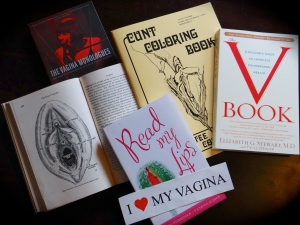It’s not a big secret that I’m a fan of porn. I also realize that a confession like that can make a lot of different people uncomfortable (or even angry). I’m planning a future post on porn from a more societal perspective, but for now, I wanted to share a few of my favorite well-known performers in the porn industry!
Stoya
Yes, Stoya is beautiful. Her pale skin, small breasts, and mildly punky appearance (especially when she had pierced nipples & blue/purple hair) were the first things to catch my eye. But a pretty face isn’t enough to make me seek out more of a porn star’s work for years to come. No, I return to Stoya’s videos because she makes sex look fun. She giggles, squeaks, and makes the absolute best sex faces. Her scenes effortlessly switch from playful and light-hearted to rough and breathtakingly passionate, reminding me that intimacy is rarely “serious business.”
As if I needed any more reasons to adore Stoya, she’s also very talented off screen. She writes fantastic articles for Vice and educates about consent and adult performers rights as part of the Adult Performer Advocacy Committee. Her blog and Instagram are intellectual but down-to-earth — filled with mentions of her favorite books, adorable photos of her many cats, and occasional appearances from her real-life partner, James Deen.
James Deen
***On November 28, 2015, Stoya confessed on Twitter that she was raped by James Deen. I can no longer support him as a person or suggest him as a performer.***
Deen has a certain charisma that is absent in a lot of male performers. Whether he’s doing mainstream porn or BDSM, his scenes aren’t focused on what he’s doing to a woman, but what he’s doing with her. I am continuously in awe of the on-screen chemistry that he shares with all of his female co-stars — especially Stoya. He’s always pulling them close, grasping them tightly, and whispering into their ears. (What I wouldn’t give to know what he’s whispering!) For me, his confidence and dominance are even more attractive than his physical appearance, but I can’t deny that I am also really curious about his signature vibrator.
To make him even more charming, he seems to have a very carefree sense of humor. This sometimes carries over into his work, like the internet-famous “Lemon Stealing Whore” clip and the video behind “I am a baby panda! I do what I want!” (Confused? You can read about it on his blog.) He also does an online video series called James Deen Loves Food where you can see him make a $580.37 burrito, taste test 27 different kinds of mustard, and occasionally lose some clothing.
Buck Angel
I firmly believe that porn can be used for more than just helping people achieve orgasm. As the self-proclaimed “Man with a Pussy,” Buck challenges our society’s gender dichotomy. He helps make transgendered individuals more visible in the sex industry and the media at large. His work with trans women forces viewers to question if what they are watching is still mainstream heterosexual porn — or if perhaps they should abandon those labels altogether. His body positive attitude towards his vagina disproves the widely-held belief that all transgendered individuals choose bottom surgery. Some do and some don’t. It’s a personal decision.
I highly suggest watching Dan Hunt’s 2013 documentary, Mr. Angel. (At the time of this post, you can find it streaming on Netflix.) Buck’s Youtube channel also offers a lot of uplifting and educational messages for trans men, including his Public Cervix Announcement.
Nina Hartley
As a fellow sex-positive feminist and advocate for sex education, Nina is a big inspiration to me. Her interviews show that she is a passionate and well-spoken woman who could be the official spokesperson of the porn industry. (She is also a member of Adult Performer Advocacy Committee.) With a degree in nursing, her fame proved that a woman could be professional & educated and still choose porn because she enjoys it. Poly, bisexual, and active in the D/s lifestyle, she completely owns who she is. She has also continued to be prolific despite the fact that she is an aging female in an industry that values youth and Photoshopped beauty. And people say that you can’t be an empowered woman in porn!
Ron Jeremy
Admittedly, I have seen surprisingly little porn starring Ron Jeremy. While I find the nickname “Hedgehog” completely adorable, he’s not exactly my type. However, I do have respect for the man. Watch Porn Star: The Legend of Ron Jeremy and you’ll see that he works hard and takes his job seriously. Because of that, he has made a name for himself in an industry that commonly reduces its male performers to nameless penises. Over the years, his body has aged and changed, only making him more of an idol for the “average guy.”
He constantly shows his fun-loving nature with comedy performances and parodies of Miley Cyrus’ “Wrecking Ball” video. I also had the chance to meet him recently, and he was just as nice as I had expected — even while I was reduced to nervous giggles and awkward silence. Fun fact: He has a Master’s degree in Special Education, freaking some people out but proving to others that ‘Hey! Porn stars are real people too!’





